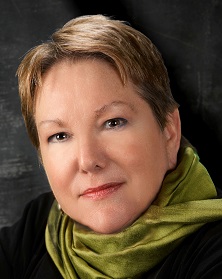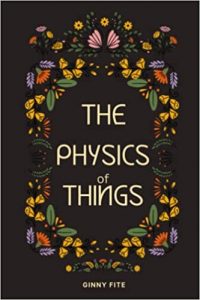A Relative to Truth—The Process of Writing a Novel
A Relative to Truth—The Process of Writing a Novel
Ginny Fite
 When I began writing The Physics of Things, I had no idea where I was going, except I knew it wasn’t a standard mystery or thriller. I didn’t make an outline, determine tentpole events, think about character, story arcs, or saving the cat. Beginning this novel was more like a cosmic big bang with energy shooting across space in every direction than the quiet determination of a plot line.
When I began writing The Physics of Things, I had no idea where I was going, except I knew it wasn’t a standard mystery or thriller. I didn’t make an outline, determine tentpole events, think about character, story arcs, or saving the cat. Beginning this novel was more like a cosmic big bang with energy shooting across space in every direction than the quiet determination of a plot line.
Usually, I don’t begin with a theme or idea. A book starts for me as a movie running in my head or the voice of someone telling me a story. I’m like a butterfly hunter; I chase the story. My job is to capture that scene and pin the voice, the tone, the details to the page. What does that look like from the outside? My son says I sit in front of my computer with my eyes closed, and then with no warning, I type like mad for a minute.
Later, I go back and think about the words I put on the page, smooth out the edges, remove the extraneous detours and put commas in their appropriate places (although comma mavens often disagree with me). But at the beginning of writing a story, I’m listening, watching, letting myself walk into the scene and look around. This process, and memory, are the real time travel.
The big questions—like, how does an abused child survive and thrive? —generally lurk somewhere other than my forebrain, percolating, dripping their heady, dark brew into my consciousness bit by bit until the thought is strong enough to taste.
About ten years ago, I had one of those eureka moments—memory, I thought, was not comprised of absolute fact like slices of cells arranged in precise order and magnified by a microscope lens. Instead, our memories are a narrative we compose in a particular order to tell ourselves who we are. Of course, the big brains had been there before me. As Oliver Sacks said, “Each of us constructs and lives a narrative, and this narrative is us, our identities.”
In 2017, I stumbled upon another idea while watching one of my favorite British crime shows, Vera, of the Ann Cleeves novels. One of the characters was conducting ground truthing, checking the accuracy of remotely sensed data by means of in-situ observations, according to the dictionary. “In situ observations” matched my idea of writing as a way to test the validity of memory. At that moment, I had a growing awareness of a story developing, like the forecast of a hurricane, but no signs yet of rain. When I’m not ready to write, I research, an old reporter habit.
I read about how the brain breaks down traumatic events into information packets, and about hemorrhagic stroke. I watched Ted talks, the modern equivalent of mind/brain seminars I attended decades ago. To this mix, I added the function of stories. Joan Didion said, “We tell ourselves stories in order to live.” But our memories, the stories we tell ourselves, are a crazy quilt stitched together by a slapdash seamstress, according to Virginia Woolf.
Without warning, I was writing a new story a week, simultaneously taking dictation and pulling my brain out through my nose using a crochet hook. Each story in The Physics of Things contains a slice of memory—a line of dialogue, a remembered event, image, feeling, or full scene—but fiction grew around each memory in nacreous layers until the story became something else.
I wrote like a demon until I had seventeen stories, and then I took a breath. What was the shape of this thing I was writing, what was the story arc, what was missing, who was this protagonist. I mean, really, what’s her name, what did she want, and what needed to happen to her? And how did the damn thing go together and end?
I brought all these shaping questions to my critique groups to pick their brains. (It takes a village to bring up a book baby.) I hoped my fellow writers would also cry and laugh, feel joy and sorrow and reflect on similar moments in their lives. That was my writing goal—to move readers to feel something more than the movement of their eyes over squiggles on a page that their brains assembled into meaning.
We are what we remember. But “Memory is a complicated thing,” Barbara Kingsolver said. “A relative to truth but not its twin.” Intertwined with questions about memory are matters of family and love, about intimacy and trust. How does the narrative we tell ourselves affect who we are and our survival? And most importantly to the main character in The Physics of Things, can we deliberately change that story?
In The Physics of Things I was aiming for “inevitable,” for each right word to be in the right place in the right sentence in the right paragraph, for each story in the sequence to hold its own independently and as a link in the chain. Inevitably is the highest goal, but I think we have to strive for that. We have to pay attention to the words on the page and what they’re telling us about the story we’re writing, the feeling they evoke, and hope those words whisk the reader into the world we created.
###
—
Ginny Fite is an award-winning journalist and author of seven published novels, three collections of poetry, and a collection of short stories. A graduate of Rutgers University and Johns Hopkins University, her 40-year career in communications included posts in newspapers, government, higher education, and a robotics R&D company. Shortlisted for the 2019 SFWP prize and a finalist for the 2020 Bakwin Prize, The Physics of Things includes Pushcart Prize-nominated stories published in The Delmarva Review, Women Arts Quarterly Journal, Heartwood Literary Magazine, and the Anthology of Appalachian Writers
https://www.instagram.com/GinnyFite/
THE PHYSICS OF THINGS
BUY HERE
Category: How To and Tips


























